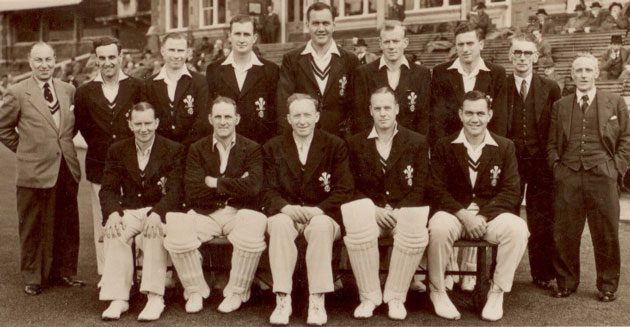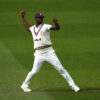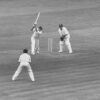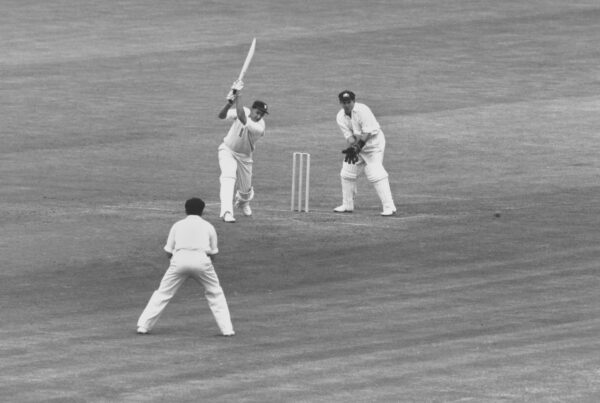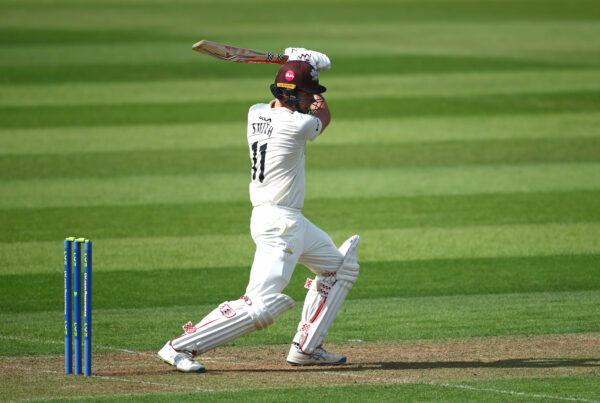The arrival of 2022 means it is now 70 years since 1952, the year that Surrey reached the summit of domestic cricket and planted their flag. Richard Spiller reports.
When Surrey entered 1952, they knew they had a team full of talent. Stuart Surridge marked his appointment as captain by predicting they would be win the County Championship for the next five years. He was wrong – they won it for the next seven, a feat which had never been achieved before and has not been since..
Richard Spiller takes a look at the team who won that first title in 1952, winning 20 out of 28 matches and totalling 256 points, the highest since the resumption of the competition following the Second World War.
Back row, from left:
Andy Sandham (coach)
Few people have devoted their lives so utterly to Surrey. Regarded for many years as Jack Hobbs’s junior partner opening the innings, he was one of 25 men to score 100 or more first-class centuries and his two Test tons included a career-best innings of 325 against West Indies. When Sandham’s first-class career ended, he became the county coach who helped to nurture Surrey’s great side of the 1950s and then went on to become the club’s scorer.
Bernie Constable
In many ways the embodiment of Surrey’s side, Bernie Constable’s unbeaten 205 was the highest score of his county’s season. It ensured they made 384-5dec against Somerset at The Oval in early July so that when rain came it enabled the bowlers to dismiss the visitors for 89 and 115. Constable made 1,482 Championship runs and his technical skill was frequently invaluable in combating difficult batting conditions which set up matches for the bowlers. He was among the backbone of the side throughout the golden run, playing on until 1964, to finish with 18,849 first-class runs, backed up by brilliant fielding in the covers and an unparalleled knowledge of opponents according to Micky Stewart.
David Fletcher
Having struggled with ill-health for much of the time since joining Surrey after the war, David Fletcher realised his promise at the top of the order, his aggregate of 1,674 leading the scorers and forming a reliable opening partnership with Eric Bedser. He was to remain a stalwart member of the side to the end of the decade and later became a much-respected coach of the county under-19s, nurturing the likes of Adam Hollioake and Mark Butcher.
Jim Laker
Jim Laker started the season as one of Wisden’s five cricketers of the year, having bowled England to victory in the previous summer’s Oval Test against South Africa and taken more than 100 wickets for Surrey. His 86 at 16 made him one of the key bowlers for Stuart Surridge – four Tests against India explaining why he was absent for 10 Championship outings – although his devastating best was still to come and he was still subject to the fickle nature of the national selectors. He remains the only man to take 19 wickets in a Test, later becoming one of the best-known voices of cricket with the BBC.
Eric Bedser
He might have been overshadowed by brother Alec but Eric Bedser’s contribution to Surrey’s title was never under-rated by his colleagues. Given the task of opening with David Fletcher, he made 1,541 Championship runs and claimed 56 wickets, opportunities with the ball limited by his fellow off-spinner Jim Laker.
Tony Lock
Tony Lock enjoyed a breakthrough year in 1952, taking 100 wickets for the first time and making his Test debut against India. The left-arm spinner’s 116 scalps at 16 saw him established as a devastating ally to Jim Laker at the other end and Lock’s value was all the greater given he snapped up 54 catches close to the bat among 831 in a career which extended to 49 Tests. He claimed 2,844 wickets in all, also playing for Western Australia and Leicestershire.
Geoff Whittaker
A clean striker of the ball, Geoff Whittaker entered the new season on the back of 1,439 runs in 1951 and might have been expecting to play a leading part. But he faded out of the side after playing 17 games and departed from Surrey after the 1953 season, falling 12 short of 5000 first-class runs.
Sandy Tait (masseur)
Before physiotherapists arrived in the world of cricket – never mind fitness and hydration experts – one of the few concessions to the physical pounding cricketers took was the masseur. Sandy Tait spent more than three decades tending to the aching muscles of Surrey players while relishing the practical jokes he played on them as well.
Herbert Strudwick (scorer)
Serving Surrey for 60 years, Herbert Strudwick removed 1,493 batsmen – a world record at the time – in his playing days as a wicketkeeper, his promise having been spotted by the daughter of the vicar at Mitcham. A first-class career which lasted from 1902-27 included 674 matches for his county and 28 Tests, which might have been many more had the selectors not preferred alternatives who could bat better but keep less well. One of the most popular players of his time then became the scorer, performing as neatly with the pencil as he had done with the gloves, before handing over to his old team-mate Andy Sandham.
Arthur McIntyre
Day in, day out, there were few better wicketkeepers than Arthur McIntyre in the English game, although his way into the Test side was blocked on all but three occasions by Godfrey Evans. Standing up to the stumps to Bedser, McIntyre produced some remarkable catches and stumpings, his speedy reflexes and neat style supporting spinners Laker and Lock as he claimed 70 victims in 1952. His formidable career was followed by taking over as coach from Andy Sandham to rebuild after the 1950s team had faded away, helping Micky Stewart to construct the side which won the County Championship in 1971.
Laurie Fishlock
It proved a triumphant final season for Laurie Fishlock, who retired at the end of 1952 after a career which had started in 1930 but was interrupted by the Second World War. Fishlock’s four England caps had come before WW2 and he was 39 when play resumed but the left-hander enjoyed a prolific final stage to his career and passed 1,000 first-class runs in his farewell summer. He also played international amateur football, turning professional to appear for several clubs.
Stuart Surridge
All out attack was Stuart Surridge’s policy and he made few compromises in pursuit of victory. Surridge inherited a talented team and drove them hard, determined to sharpen up their catching around the wicket and leading the way by snapping up 58 chances close in. He ensured personal agendas were subjugated to the general good and Surridge’s own contributions on the field were often overlooked, claiming 68 Championship wickets in the 1952 season, often sharing the new ball with Alec Bedser, and 506 in his first-class career.
Jack Parker
Like Laurie Fishlock, Jack Parker had arrived when Jack Hobbs was still playing for Surrey and retired at the end of the 1952 season. His own career was marred by the six seasons lost to war, having been selected for the 1939-40 tour to India which could not take place. The lofty Parker, an elegant batsman and useful seamer, scored 14,272 first-class runs, took 543 wickets and claimed 342 catches, bowing out with 1,109 Championship runs in that farewell summer.
Alec Bedser
Enjoying his peak years, Alec Bedser spearheaded Surrey and England’s attacks, his medium-fast bowling mixing natural inswing with a leg-cutter he developed while touring Australia in 1946-47. Bedser’s 102 Championship wickets at 15 put him top of Surrey’s bowling averages, adding 20 at 13 apiece in four Tests against India. Alec never failed to stress the support twin Eric gave him in a remarkable career which brought him 1,294 first-class wickets – 236 of them in 51 Tests – before becoming an England selector for 23 Tests, chairing the panel from 1969-81. He became Sir Alec in 1996.
Absent
Peter May
Given his England debut in 1951 when still an undergraduate, Peter May missed half of Surrey’s first Championship season through his final year at Cambridge University. When he returned, May rushed to 804 runs at 67 apiece in just eight Championship matches, finishing top of the county’s batting averages. Regarded by some as England’s finest post-war player, colleague David Fletcher remarked that “when he was at his best you just took a single and let him get on with it”. May’s magnificent career took in 66 Tests – 41 as captain – and saw him score 27,592 first-class runs despite having played his final first-class game when he was 33. He was appointed CBE and later became chairman of the England selectors.
Tom Clark
Only Stuart Surridge appeared more often than Tom Clark in Surrey’s first title season of the run and over 27 games he scored 1,184 runs. It was the first time Clark had reached four-figures and earned him his county cap, going on to be – like Fletcher and Constable – an invaluable player whose presence was as highly regarded by his colleagues through their long run of success. No mean off-spinner, the potency of Laker and Eric Bedser meant opportunities to shine were strictly rationed.
Other players to appear were Alan Brazier (three matches), Peter Loader (four), Dennis Cox (seven) and John McMahon (three).
